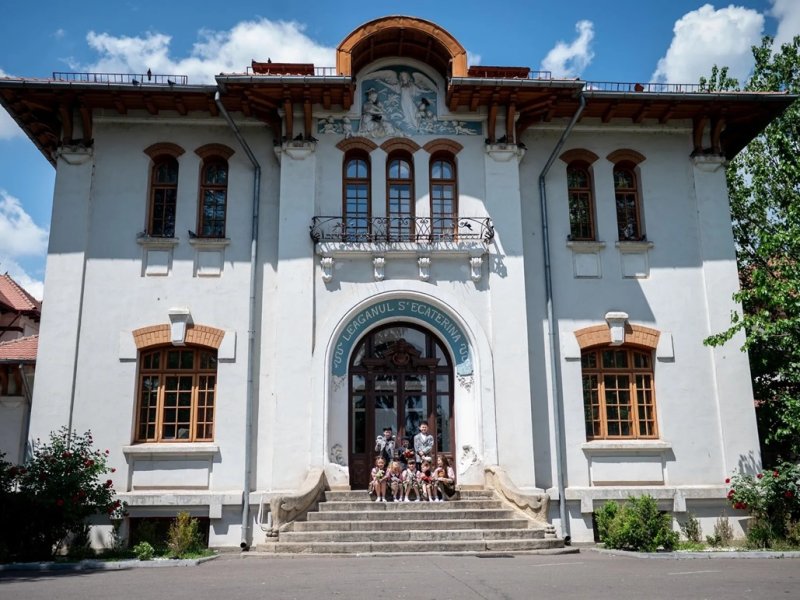The "Saint Catherine" Cradle, the Last Home of Princess Ecaterina Caradja

By Bucharest Team
- Articles
The “Saint Catherine” Cradle is one of the most representative historical monuments in Bucharest, known both for its remarkable architecture and for its exceptional social role. The institution is closely linked to Princess Ecaterina Caradja, who lived here during the last years of her life and dedicated her entire life to charitable activities.
The Establishment of the Social Assistance Society
In 1897, the Social Assistance Society “Saint Catherine Cradle” was founded with the aim of supporting poor newborn children and establishing an institute dedicated to their upbringing.
This private initiative primarily aimed to provide a safe environment for children from impoverished families, for those left without a mother, and for unmarried young women who became mothers.
The only condition imposed was that they breastfeed not only their own child but also an orphaned newborn, thereby giving the little ones a chance to grow up in a protected environment.
The Story of Princess Ecaterina Caradja
The society was founded at the initiative of Irina Cantacuzino, who sought to ease her grief caused by the loss of her only daughter from her first marriage. Ecaterina Olimpia Georgeta had been kidnapped at the age of three and taken abroad, only to be brought back to Romania in 1906.
The child was raised by her maternal grandfather, Prince Gheorghe Grigore Cantacuzino, nicknamed Nababul, a former Prime Minister of Romania, and received an elite education in England, France, Romania, and Belgium, learning five foreign languages. In 1914, just before the start of the First World War, she married Prince Constantin Caradja.
Charitable Work of Princess Caradja
After the war, Princess Caradja returned to Bucharest and took over the administration of the “Saint Catherine” Cradle, which at that time housed 300 children. During the 1920s, she introduced the foster care system in Romania and expanded the activities of the institution into 11 communes in Prahova County.
Children over the age of two were placed in peasant families who received a stipend and were obligated to send the children to schools established by the Cradle, ensuring their education. During this period, the number of children simultaneously cared for by the Cradle reached 4,500.
The “Saint Catherine” Cradle became the only institution in Romania affiliated with the International Union for Child Welfare in Geneva, thus consolidating its international prestige and establishing a model of good practice in child protection.
Communist Era and the Princess’s Exile
After the communist regime was established, the orphanages and Princess Caradja’s foundation were nationalized. Alexandra, her only living daughter, who lived in Paris, helped her escape Romania at the beginning of 1952 with the support of French intelligence services.
Ecaterina Caradja left the country hidden on an oil tanker navigating the Danube and arrived in Vienna after eight weeks. In 1955, she received a visa for the United States and settled in Hill County, Texas, where she lived for over 35 years, continuing her charitable work.
Education and Foster Care System
The “Saint Catherine” Cradle was not limited to sheltering children; it was also an educational center. Through the foster care system, children received instruction both in the Cradle’s schools and in rural households, where they learned practical skills and trades. This holistic approach ensured the harmonious development of the children and prepared them for life.
Princess Caradja placed great importance on education, culture, and moral values, transforming the Cradle into a successful model throughout the country. Her activities changed the destinies of thousands of children, offering them the chance for a safe and prosperous childhood despite social and economic difficulties of the time.
Return to Romania and the legacy of “Saint Catherine” Cradle
After the 1989 Revolution, Princess Caradja returned to Romania and chose to reside in her old orphanage, continuing to keep alive the memory of her charitable work. She lived there until the venerable age of 100, passing away on May 26, 1993.
Today, the “Saint Catherine” Cradle remains a symbol of philanthropy, child care, and the tireless dedication of a princess who devoted her entire life to the welfare of others. The institution is not only a historical memory but also a living example of social responsibility, education, and compassion.
Through her work, Princess Ecaterina Caradja transformed personal suffering into help for thousands of children, leaving an invaluable cultural and social legacy that continues to inspire today. The “Saint Catherine” Cradle is not just a monument but also a landmark of generosity and moral values that defined the entire life of Princess Caradja.
We also recommend: Măruca Cantacuzino, the Troubled Princess of Bucharest. George Enescu’s Wife Poured Acid on Her Face to Punish Her Lover






























